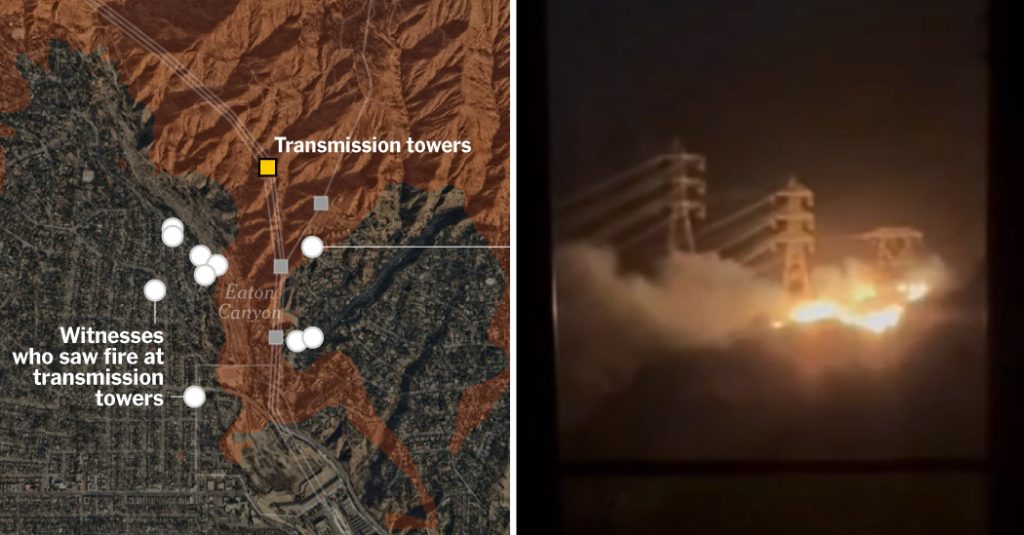The devastating Eaton Fire, which tragically claimed 17 lives and destroyed thousands of structures in Southern California in January 2024, has sparked an intensive investigation into its origin. Early evidence points towards the possibility of electrical infrastructure involvement, specifically a set of high-voltage transmission towers located in Eaton Canyon, near where the fire ignited. Eyewitness accounts describe a bright flash of light followed by flames at the base of one of these towers, coinciding with a period of extreme winds exceeding 100 miles per hour. A newly surfaced surveillance video appears to corroborate these accounts, showing flashes of light in the vicinity of the towers just moments before flames erupt. This video, along with eyewitness testimony, has become a crucial piece of evidence in the ongoing investigation.
While Southern California Edison (SCE), the utility responsible for the power lines in the area, initially denied any electrical anomalies in the hours leading up to the fire, their stance has since shifted. SCE now acknowledges a fault detected at a substation five miles away from the ignition point at the exact time the video shows the flashes of light. However, they maintain that the high-voltage transmission lines in Eaton Canyon remained operational and showed no signs of malfunction. Despite their internal guidelines suggesting de-energizing lines under such extreme wind conditions, SCE kept the power flowing through these lines. The utility defends its decision, arguing that de-energizing transmission lines is a drastic measure with widespread power disruption consequences, requiring a high threshold of perceived risk.
The investigation into the Eaton Fire’s origin has raised critical questions about the role of high-voltage transmission lines in sparking wildfires. While smaller distribution lines, often running on wooden poles, are more susceptible to wind damage, high-voltage transmission lines are not immune to faults. Experts point to the phenomenon of arcing, where electricity jumps between lines, creating intense heat and sparks that can ignite dry vegetation below. Molten metal dropping from the towers can also contribute to fire ignition. This potential ignition source is being seriously considered by investigators, who have been observed combing the area around the towers with metal detectors, searching for evidence of melted metal or other signs of arcing.
SCE’s initial denial of any electrical issues, followed by the acknowledgment of a fault at a nearby substation, has raised concerns about transparency and accountability. The utility initially resisted requests to preserve data from the area, claiming no evidence linking their equipment to the fire’s ignition. However, a judge subsequently ordered SCE to provide data from distribution circuits near the suspected origin point. This legal battle underscores the high stakes of the investigation, with potential liability implications for SCE and the possibility of significant financial repercussions.
The financial ramifications of the Eaton Fire are substantial, with estimated losses reaching up to $10 billion. This raises the specter of another major wildfire-related financial crisis for a California utility, reminiscent of Pacific Gas & Electric’s (PG&E) bankruptcy following the devastating 2018 Camp Fire. PG&E’s case, involving 84 counts of involuntary manslaughter, serves as a stark reminder of the potential consequences of utility negligence in wildfire incidents. SCE’s stock has already experienced a significant decline amidst growing concerns about their potential liability in the Eaton Fire.
However, a controversial 2019 California law, enacted following the Camp Fire and PG&E’s bankruptcy, provides some protection for utilities against runaway liability in wildfire cases. This legislation established a $21 billion fund that utilities can draw upon if fire damages exceed $1 billion. Critics argue that this effectively shields utilities from the full financial impact of their actions, shifting some of the burden to ratepayers and taxpayers. While the law mandates new wildfire prevention measures for utilities, it has also been criticized for potentially incentivizing less rigorous safety practices. The Eaton Fire investigation and its potential legal fallout will likely test the limits of this legislation and reignite the debate about utility accountability in wildfire-prone California.










